- About us
- Contact us: +1.641.472.4480, hfi@humanfactors.com
Cool stuff and UX resources
Why is social media so important for companies?
It is 2013, and social networks are booming. People seem to be thronging in hordes to the various social media sites. Here are some examples of the kind of numbers social media sites are attracting:
- Facebook boasts of a whopping 1.11 billion active users per month
- Google+ has 343 million active users
- Twitter has 200 million active users
- Pinterest is catching on with 50 million active users
Not only is the volume of active users large, but the average time spent on social networking sites is about 15 hours per month. With numbers like these I can imagine companies salivating at the prospect of making money on these social networking-hungry users.
Exciting, tantalizing, and lucrative ‚ÄĒ social commerce is big now. Booz & Company predicts $15 billion in social commerce revenues by 2014. This is approximately 10% of what is expected to come from total ecommerce revenue.
Executives find social media so important now, that they feel that they leverage it to support all aspects of the ecommerce funnel by
- Increasing awareness and consideration through advertising
- Reducing help desk costs through consumer forums
- Listening to and understanding consumer perception
- Supporting advocacy through making recommendations viral
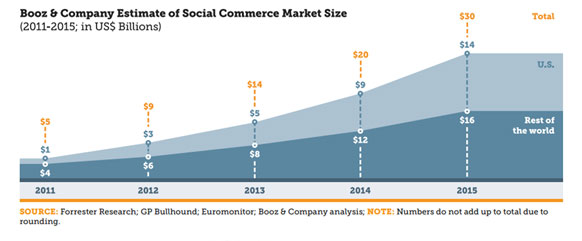
What challenges do companies face?
As companies struggle to embrace this new opportunity, they realize that monetizing social networks is not all that easy. Typically, companies take two approaches to integrating social media into their services.
The first method is setting up a direct presence on a social networking site such as Facebook or Twitter.
The second method involves use of social plug-ins to enable social functionality on an existing site. Facebook, Twitter and other such sites make it possible to integrate recommendations and interests from the customers’ friends, in order to influence purchase decisions.
Both of these approaches are fraught with many challenges. Some of these key challenges are illustrated below.

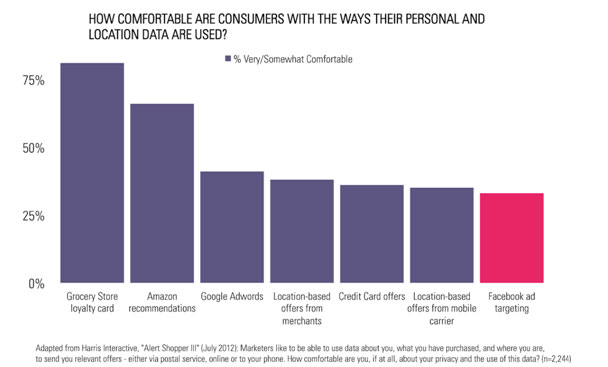
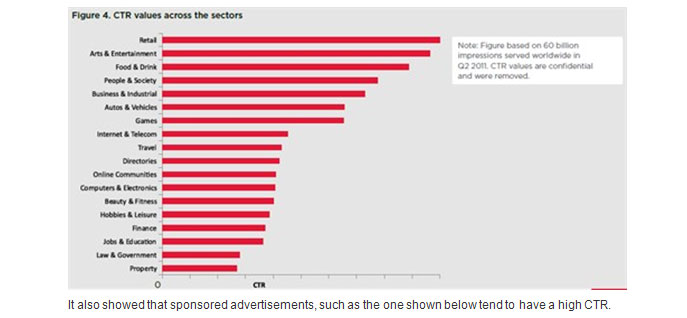

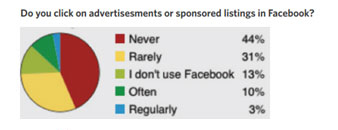
Advertising vs. Conversion
One of the major applications of social commerce is reaching out to potential customers through advertising. Companies push targeted advertisements to customers in hope of enticing them towards conversion.
Targeted advertising, though seemingly wonderful, can be of concern, considering that it could scare away your customers. Customers don’t enjoy the fact that their every click, conversation, purchase, etc. is being tracked.
Customers are also very concerned about social networks accessing their data without their permission to target advertising. It makes them feel vulnerable and exposed, causing them to lose trust. The following chart from Harris Interactive’s “Alert Shopper III” shows that consumers associate the least amount of trust with targeted ads from Facebook. Consumers are especially concerned when it comes to Facebook accessing their location and personal data.
Commonwealth Bank had attempted to create a Facebook application where customers were required to enter their account credentials to get more targeted recommendations. Here is an extract from the beta testing of the application, where customers had a very strong reaction to trusting Facebook with their financial details.
“At the moment, there is no way in the world I would even consider this. It is just not safe enough. It’s fine for photos or comments you want the world to see but privacy in Facebook is a joke.
So, is Facebook going to broadcast all your financial transactions because you didn’t spend enough effort to tailor your privacy settings? And what happens if you log in one day and find they decided to transfer all your money into an “official” Facebook branded account without your permission?
LOL ‚Ķ sounds fantastic ‚Ķ until it “frictionlessly shares” your account login details to your 574 friends’ news feeds!”
The other challenge with advertising on social networks is how success is measured. The typical measure for success here is the clickthrough rate (CTR). This, very simply, is the measure of the number of clicks on the promoted advertisement.
Greenlight, Search & social media survey conducted in May 2012 illustrates the CTR on Facebook across different sectors. The study revealed that retail delivered the CTR when compared to other sectors.
It also showed that sponsored advertisements such as the one shown below tend to have a high CTR.
Though a good CTR shows that customers are expressing initial interest, that may not be enough. A component of the same study shows a contradictory side of things. This component used a survey conducted across 500 participants, mostly from Europe and North America, but few from Asia. The survey showed that only 10% participants clicked on advertisements in Facebook while 44% never clicked on them. This showed that social networking site users, while engaged in “brief but intimate” conversations, have little patience for interruptive advertising, even if it appears relevant to them.
In conclusion, though CTR for the retail sector might be going up, the transaction volume may not. Consumers’ trust associated with advertisements on social networks is poor. Though consumers may click on advertisements sponsored by their friends, this may not be enough to influence their transaction decision.
Reducing helpdesk costs
Servicing customers who raise requests, concerns and issues on social media is an important area for companies. For customers who previously sought to get their grievances addressed through writing letters and calling the call center, this seems to be a blessing.
A survey conducted by communications agency Fishburn Hedges and Echo Research amongst 2,000 UK adults showed that in April 2012, 36% had used a social media platform to contact a big company.
Some 65% of those surveyed said they believed social media was a better way to communicate with companies than call centers.
The downside of this is that leveraging social networking sites to address customer grievances can also backfire. Many companies have discovered that simply providing a social media destination for customers to provide feedback can turn quite ugly.
Qantas discovered this when it encouraged people to use the Qantas Luxury hashtag to share positive experiences of flying with the Australian airline. Instead of sharing positive feedback, disgruntled customers showered thousands of complaints and sarcastic comments.
McDonald's was also stung when it created the McDStories hashtag, hoping to receive a stream of positive tweets. McDonald's stopped using the hashtag after just two hours of receiving a barrage of negative tweets. Unfortunately by then the hashtag had taken on a life of its own and continued to be used.
What companies are realizing is that social media presence can very easily end up being places for disgruntled customers to rant and hold customer helpdesks at ransom for the price of their fickle loyalty.

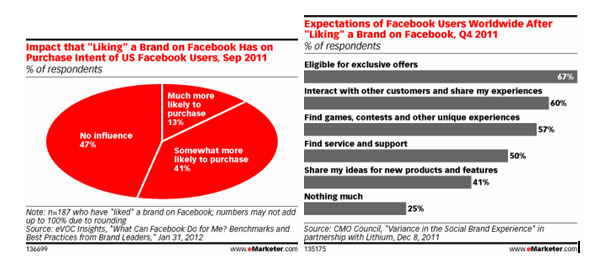

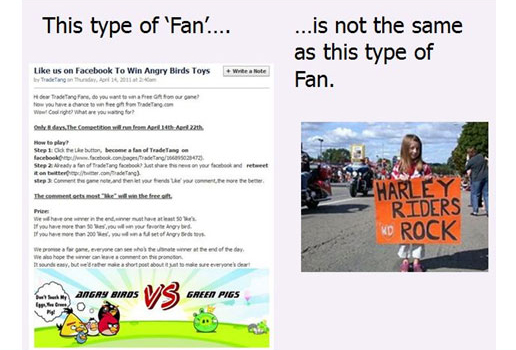
Customer loyalty & advocacy
Gauging customer loyalty and advocacy through social media is hard. One of the key ways that marketers determine customer loyalty & advocacy is through measuring “like”s and “+1”s that customers post.
When it comes to measuring loyalty, Facebook “likes” on pages don't always translate into brand loyalty. Two visualizations below from eMarketer help illustrate the behavior of consumer who “like” pages through Facebook. The eVOC insights study illustrates that a majority of consumers who “liked” a brand are not very likely to arrive at purchase intent. The CMO Council study shows that 67 percent of consumers “like” a page in the hope of being eligible for exclusive offers.
A recent campaign by UNICEF stresses that Facebook “likes” don’t amount to much. Even with 2.6 million likes on its Facebook page, UNICEF really isn’t making enough money to support the various causes. Facebook “likes” are not equal to money or transactions. They just showcase the lowest form of commitment that flippant Facebook users are ready to make.
In the case of customer advocacy, “likes” again don’t add up. Steve Knapp, Director of brand activation, senior partner at Carmichael Lynch, states that consumers may like your company, but that doesn't mean you have their attention. He elaborates that research indicates that anywhere from 3% to 10% of the Facebook fan base has hidden your company updates from their news feeds.
Facebook “likes” also don’t work as advocacy, as they have minimal influence on the friends who receive them. Researchers at Harvard University examined the Facebook activity of about 200 college students over four years, beginning at the start of their college careers in March 2006. Information was collected annually about their social networks, including who they were 'friends' with, and what they “liked” online. This data was combined with academic and housing data on each of the students.
Researchers concluded that users are more inclined to befriend people because they have a lot in common, rather than adopt the same tastes and preferences of current friends.
How do we get social commerce right?
The challenge here is to stop looking at social commerce as a quick bandage solution to business success. Executives need to start looking at it through the lens of user experience (UX) strategy. A well balanced UX strategy is derived from a combination of the right channels, research based customer understanding and persuasion/design strategy.
Build a customer understanding
One of the most important components of implementing social commerce is to understand customers and how they engage with social media. Google Advanced Global Mobile Trends 2011 states that the rules of engagement around social media are unequivocal. We cannot assume that Facebook or Twitter are being used similarly across the customer population. It is evident that users create their own rules around how they will leverage/use a certain social network or even the different communication modalities present within it. Thus it becomes imperative to conduct research which helps us understand the customers better. Ask questions which help clarify…
- How do they use different social network sites?
- How do they use the different communication modalities within social network sites?
- How do they associate with others through social media and how would that influence their click/purchase decisions?
- What are their drives, blocks, motivations and feelings around how they associate with your product/service?
Which channel is right?
Social media is accessed from across multiple channels. Customers tend to use social media differently across channels. An understanding of how customers engage with different channels can be gained through ecosystem research. An ecosystem model illustrates the channels, players, scenarios, needs and opportunities that surround the customer. This helps us look at the relationships which could be leveraged to engage the customer.
One of the important trends to look out for, with regards to social commerce, is the rise of mobile phones. It is easy to see that in the coming years, much of social networking presence will be through mobile devices.
This symbiosis for the first time provides a great way to do away with “digital dualism” and to create a singular seamless experience across physical and digital devices. Though companies strive to integrate mobile with their services, the full potential of mobile and its integration with social media is yet to be seen.

Develop a Persuasion/Design Strategy
Once there is a sufficient understanding of the customer and the channels he employs, the third component is to develop a persuasion strategy. A careful selection of persuasion tools needs to be threaded together contextually to the customer type. The tools may also differ based on what you want your customers to do. So, what do you want them to do? Should they…
- Do more than just click on advertisements on social networks
- Leave positive feedback
- Be loyal to your brand and purchase repeatedly
- Become advocates and influence their peers to become your customers
The promise of social commerce is tremendous, but we have to be mindful of the challenges it poses. It is only through following a process-driven approach of understanding your customers and the associated complexities of social media that you will be able to develop a UX strategy that achieves business success.
More information
Eric Schaffer, founder and CEO of Human Factors International, discusses how UX strategy translates executive intent into a clear strategic direction by defining a motivation strategy unique to specific users and creating a seamless cross channel solution. Request this white paper on UX strategy to learn more.
References
- Challenges for the fast growth in social commerce
- How consumers really feel about data privacy
- Do social networks improve e-Commerce? A study on social marketplaces
- Are Twitter and Facebook changing the way we complain?
- When It Comes To Facebook, A Like Does Not Equal A Sale
- What can Facebook do for me? Benchmarks and best practices from brand leaders
- Do Facebook likes indicate marketer ROI?
- Harvard study shows Facebook friends don't influence your taste
Message from the CEO, Dr. Eric Schaffer ‚ÄĒ The Pragmatic Ergonomist
Leave a comment here
Reader comments
Arvind Krishan
CASA
Very good paper. Well supported with intensive research.
Subscribe
Sign up to get our Newsletter delivered straight to your inbox
Privacy policy
Reviewed: 18 Mar 2014
This Privacy Policy governs the manner in which Human Factors International, Inc., an Iowa corporation (‚ÄúHFI‚ÄĚ) collects, uses, maintains and discloses information collected from users (each, a ‚ÄúUser‚ÄĚ) of its humanfactors.com website and any derivative or affiliated websites on which this Privacy Policy is posted (collectively, the ‚ÄúWebsite‚ÄĚ). HFI reserves the right, at its discretion, to change, modify, add or remove portions of this Privacy Policy at any time by posting such changes to this page. You understand that you have the affirmative obligation to check this Privacy Policy periodically for changes, and you hereby agree to periodically review this Privacy Policy for such changes. The continued use of the Website following the posting of changes to this Privacy Policy constitutes an acceptance of those changes.
Cookies
HFI may use ‚Äúcookies‚ÄĚ or ‚Äúweb beacons‚ÄĚ to track how Users use the Website. A cookie is a piece of software that a web server can store on Users‚Äô PCs and use to identify Users should they visit the Website again. Users may adjust their web browser software if they do not wish to accept cookies. To withdraw your consent after accepting a cookie, delete the cookie from your computer.
Privacy
HFI believes that every User should know how it utilizes the information collected from Users. The Website is not directed at children under 13 years of age, and HFI does not knowingly collect personally identifiable information from children under 13 years of age online. Please note that the Website may contain links to other websites. These linked sites may not be operated or controlled by HFI. HFI is not responsible for the privacy practices of these or any other websites, and you access these websites entirely at your own risk. HFI recommends that you review the privacy practices of any other websites that you choose to visit.
HFI is based, and this website is hosted, in the United States of America. If User is from the European Union or other regions of the world with laws governing data collection and use that may differ from U.S. law and User is registering an account on the Website, visiting the Website, purchasing products or services from HFI or the Website, or otherwise using the Website, please note that any personally identifiable information that User provides to HFI will be transferred to the United States. Any such personally identifiable information provided will be processed and stored in the United States by HFI or a service provider acting on its behalf. By providing your personally identifiable information, User hereby specifically and expressly consents to such transfer and processing and the uses and disclosures set forth herein.
In the course of its business, HFI may perform expert reviews, usability testing, and other consulting work where personal privacy is a concern. HFI believes in the importance of protecting personal information, and may use measures to provide this protection, including, but not limited to, using consent forms for participants or ‚Äúdummy‚ÄĚ test data.
The Information HFI Collects
Users browsing the Website without registering an account or affirmatively providing personally identifiable information to HFI do so anonymously. Otherwise, HFI may collect personally identifiable information from Users in a variety of ways. Personally identifiable information may include, without limitation, (i)contact data (such as a User’s name, mailing and e-mail addresses, and phone number); (ii)demographic data (such as a User’s zip code, age and income); (iii) financial information collected to process purchases made from HFI via the Website or otherwise (such as credit card, debit card or other payment information); (iv) other information requested during the account registration process; and (v) other information requested by our service vendors in order to provide their services. If a User communicates with HFI by e-mail or otherwise, posts messages to any forums, completes online forms, surveys or entries or otherwise interacts with or uses the features on the Website, any information provided in such communications may be collected by HFI. HFI may also collect information about how Users use the Website, for example, by tracking the number of unique views received by the pages of the Website, or the domains and IP addresses from which Users originate. While not all of the information that HFI collects from Users is personally identifiable, it may be associated with personally identifiable information that Users provide HFI through the Website or otherwise. HFI may provide ways that the User can opt out of receiving certain information from HFI. If the User opts out of certain services, User information may still be collected for those services to which the User elects to subscribe. For those elected services, this Privacy Policy will apply.
How HFI Uses Information
HFI may use personally identifiable information collected through the Website for the specific purposes for which the information was collected, to process purchases and sales of products or services offered via the Website if any, to contact Users regarding products and services offered by HFI, its parent, subsidiary and other related companies in order to otherwise to enhance Users’ experience with HFI. HFI may also use information collected through the Website for research regarding the effectiveness of the Website and the business planning, marketing, advertising and sales efforts of HFI. HFI does not sell any User information under any circumstances.
Disclosure of Information
HFI may disclose personally identifiable information collected from Users to its parent, subsidiary and other related companies to use the information for the purposes outlined above, as necessary to provide the services offered by HFI and to provide the Website itself, and for the specific purposes for which the information was collected. HFI may disclose personally identifiable information at the request of law enforcement or governmental agencies or in response to subpoenas, court orders or other legal process, to establish, protect or exercise HFI’s legal or other rights or to defend against a legal claim or as otherwise required or allowed by law. HFI may disclose personally identifiable information in order to protect the rights, property or safety of a User or any other person. HFI may disclose personally identifiable information to investigate or prevent a violation by User of any contractual or other relationship with HFI or the perpetration of any illegal or harmful activity. HFI may also disclose aggregate, anonymous data based on information collected from Users to investors and potential partners. Finally, HFI may disclose or transfer personally identifiable information collected from Users in connection with or in contemplation of a sale of its assets or business or a merger, consolidation or other reorganization of its business.
Personal Information as Provided by User
If a User includes such User’s personally identifiable information as part of the User posting to the Website, such information may be made available to any parties using the Website. HFI does not edit or otherwise remove such information from User information before it is posted on the Website. If a User does not wish to have such User’s personally identifiable information made available in this manner, such User must remove any such information before posting. HFI is not liable for any damages caused or incurred due to personally identifiable information made available in the foregoing manners. For example, a User posts on an HFI-administered forum would be considered Personal Information as provided by User and subject to the terms of this section.
Security of Information
Information about Users that is maintained on HFI’s systems or those of its service providers is protected using industry standard security measures. However, no security measures are perfect or impenetrable, and HFI cannot guarantee that the information submitted to, maintained on or transmitted from its systems will be completely secure. HFI is not responsible for the circumvention of any privacy settings or security measures relating to the Website by any Users or third parties.
Correcting, Updating, Accessing or Removing Personal Information
If a User’s personally identifiable information changes, or if a User no longer desires to receive non-account specific information from HFI, HFI will endeavor to provide a way to correct, update and/or remove that User’s previously-provided personal data. This can be done by emailing a request to HFI at hfi@humanfactors.com. Additionally, you may request access to the personally identifiable information as collected by HFI by sending a request to HFI as set forth above. Please note that in certain circumstances, HFI may not be able to completely remove a User’s information from its systems. For example, HFI may retain a User’s personal information for legitimate business purposes, if it may be necessary to prevent fraud or future abuse, for account recovery purposes, if required by law or as retained in HFI’s data backup systems or cached or archived pages. All retained personally identifiable information will continue to be subject to the terms of the Privacy Policy to which the User has previously agreed.
Contacting HFI
If you have any questions or comments about this Privacy Policy, you may contact HFI via any of the following methods:
Human Factors International, Inc.
PO Box 2020
1680 highway 1, STE 3600
Fairfield IA 52556
hfi@humanfactors.com
(800) 242-4480
Terms and Conditions for Public Training Courses
Reviewed: 18 Mar 2014
Cancellation of Course by HFI
HFI reserves the right to cancel any course up to 14 (fourteen) days prior to the first day of the course. Registrants will be promptly notified and will receive a full refund or be transferred to the equivalent class of their choice within a 12-month period. HFI is not responsible for travel expenses or any costs that may be incurred as a result of cancellations.
Cancellation of Course by Participants (All regions except India)
$100 processing fee if cancelling within two weeks of course start date.
Cancellation / Transfer by Participants (India)
4 Pack + Exam registration: Rs. 10,000 per participant processing fee (to be paid by the participant) if cancelling or transferring the course (4 Pack-CUA/CXA) registration before three weeks from the course start date. No refund or carry forward of the course fees if cancelling or transferring the course registration within three weeks before the course start date.
Cancellation / Transfer by Participants (Online Courses)
$100 processing fee if cancelling within two weeks of course start date. No cancellations or refunds less than two weeks prior to the first course start date.
Individual Modules: Rs. 3,000 per participant ‚Äėper module‚Äô processing fee (to be paid by the participant) if cancelling or transferring the course (any Individual HFI course) registration before three weeks from the course start date. No refund or carry forward of the course fees if cancelling or transferring the course registration within three weeks before the course start date.
Exam: Rs. 3,000 per participant processing fee (to be paid by the participant) if cancelling or transferring the pre agreed CUA/CXA exam date before three weeks from the examination date. No refund or carry forward of the exam fees if requesting/cancelling or transferring the CUA/CXA exam within three weeks before the examination date.
No Recording Permitted
There will be no audio or video recording allowed in class. Students who have any disability that might affect their performance in this class are encouraged to speak with the instructor at the beginning of the class.
Course Materials Copyright
The course and training materials and all other handouts provided by HFI during the course are published, copyrighted works proprietary and owned exclusively by HFI. The course participant does not acquire title nor ownership rights in any of these materials. Further the course participant agrees not to reproduce, modify, and/or convert to electronic format (i.e., softcopy) any of the materials received from or provided by HFI. The materials provided in the class are for the sole use of the class participant. HFI does not provide the materials in electronic format to the participants in public or onsite courses.


